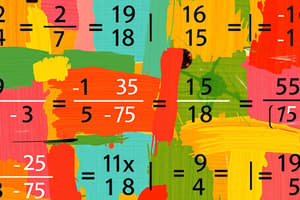Podcast
Questions and Answers
How do you simplify fractions?
How do you simplify fractions?
By finding the greatest common divisor (GCD) of the numerator and denominator, then dividing both by the GCD.
What is the process of simplifying decimals?
What is the process of simplifying decimals?
Removing any trailing zeros that do not affect the value of the number and adjusting the decimal point accordingly.
What is the significance of adjusting the decimal point in decimals?
What is the significance of adjusting the decimal point in decimals?
Adjusting the decimal point ensures the correct representation of the value and removes any unnecessary zeros.
Why is finding the lowest form of a fraction important?
Why is finding the lowest form of a fraction important?
What is the common misconception about simplifying decimals?
What is the common misconception about simplifying decimals?
Why is simplifying fractions and decimals important?
Why is simplifying fractions and decimals important?
What are some advanced scenarios you might encounter when simplifying fractions and decimals?
What are some advanced scenarios you might encounter when simplifying fractions and decimals?
How can improving your skill in simplifying numbers benefit your mathematical understanding?
How can improving your skill in simplifying numbers benefit your mathematical understanding?
Flashcards are hidden until you start studying
Study Notes
Simplifying Numbers: Fractions, Decimals, and More
In the realm of mathematics, simplifying numbers is an essential skill for navigating complex concepts, including fractions and decimals. This article will guide you through the process of streamlining these numbers, making them easier to work with and understand.
Fractions
Fractions are numbers that represent a part of a whole. For example, (\frac{1}{2}) represents one-half of a whole. To simplify fractions, we look for the greatest common divisor (GCD) of the numerator and the denominator.
Example: To simplify (\frac{12}{18}), we find the GCD of 12 and 18, which is 6. Then, we divide both the numerator and denominator by the GCD:
[ \frac{12}{18} = \frac{12 \div 6}{18 \div 6} = \frac{2}{3} ]
Decimals
Decimals are a way of representing fractions using a base-ten system, with a decimal point to separate whole numbers and fractions. To simplify decimals, we remove any trailing zeros that do not affect the value of the number and adjust the decimal point accordingly.
Example: To simplify 0.0034, we remove the trailing zeros:
[ 0.0034 \rightarrow 0.003 ]
Simplifying Numbers
In general, simplifying numbers involves finding the lowest form of a fraction or decimal. This can be achieved by:
- Finding the GCD of the fraction's numerator and denominator.
- Removing trailing zeros in decimals.
- Adjusting the decimal point in decimals.
Common Misconceptions
One common misconception is that simplifying decimals means rounding them to the nearest whole number. However, simplifying decimals only removes trailing zeros and adjusts the decimal point if necessary.
Applications
Simplifying fractions and decimals is an essential step in performing calculations, solving equations, and understanding mathematical concepts such as ratios, rates, and percentages.
Advanced Topics
As you advance, you'll encounter more complex scenarios, such as simplifying fractions with negative denominators, mixed numbers, and decimal notation with negative exponents. But don't worry, the fundamental principles of simplifying remain the same—find the GCD of the numerator and denominator, and adjust the decimal point in decimals.
In Conclusion
Simplifying numbers is a fundamental skill that will help you in countless mathematical applications. By understanding how to simplify fractions and decimals, you'll be able to tackle more advanced topics with confidence and clarity. So, practice simplifying numbers and watch your understanding flourish!
Studying That Suits You
Use AI to generate personalized quizzes and flashcards to suit your learning preferences.



